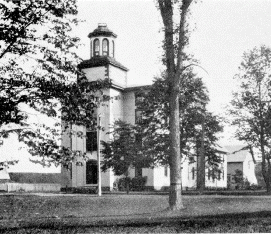

|
|
|
|
|
|
|
|
|
|
 History
of Pomeroy Hall (6)
History
of Pomeroy Hall (6)
Although the initial appropriations which accompanied the creation of the Agricultural Experiment Station were insufficient to redo the old Medical College building, the passage of the Hatch Act made funds available for its improvement. In 1890 a number of alterations were made. A 100 light Springfield gas lighting system was installed in the Experiment Station laboratory and offices.39
The old first story laboratory of the Medical College was converted into a milk laboratory,40 and the second story of the 1880 addition was converted into a botanical laboratory which was used until Williams Hall was completed in 1896.41 The seventeen foot high third story of the main block was divided into two stories and converted into dormitory rooms for the growing number of agriculture students.42
The large round arched windows of the 1858 third story addition were removed and replaced with two windows. The new third story windows had splayed lintels similar to the first and second story windows, while the new fourth story windows were shorter, with segmental arch lintels which extended above the brick corbelling.
Eight dormitory rooms were built in the upper two floors of the main block and two were built in the third story of the 1858 ell.43 By the following year the dormitory rooms were filled and some students were forced to seek housing in private residences in town.44
In 1892 the University of Vermont awarded its first baccalaureate degree in agriculture.45 The following year Joseph L. Hills replaced Professor Cooke as director of the Vermont Agricultural Experiment Station.46 Professor Hills had spent the previous five years as agricultural chemist at the Station. For the first six months after he was hired in 1888, he used the two rooms on the west side of the third story of the 1858 ell for a bedroom and a study. Shortly after becoming director, Hills had the first story lecture room in the main block of the building converted into two offices on the west side and a classroom on the east side. He also had the first story of the 1880 ell and the Experiment Station barn converted for use by Dr. Rich for veterinary science instruction and research.47 These changes probably occurred around 1895.
In his later years, Joseph Hills recollected:
The funds which were available in 1887 were insufficient completely to renovate the old medical college and only the second floor of the main building and of the first ell were used to by the new enterprise as a chemical laboratory and as offices. The lingering odor of the dissection room pervaded the third story and the skeletal fragments littered the cellar. The writer in his pre-marital days slept in the former cadaver storage room. Twas an eerie environment in which to inaugurate agricultural research work.48